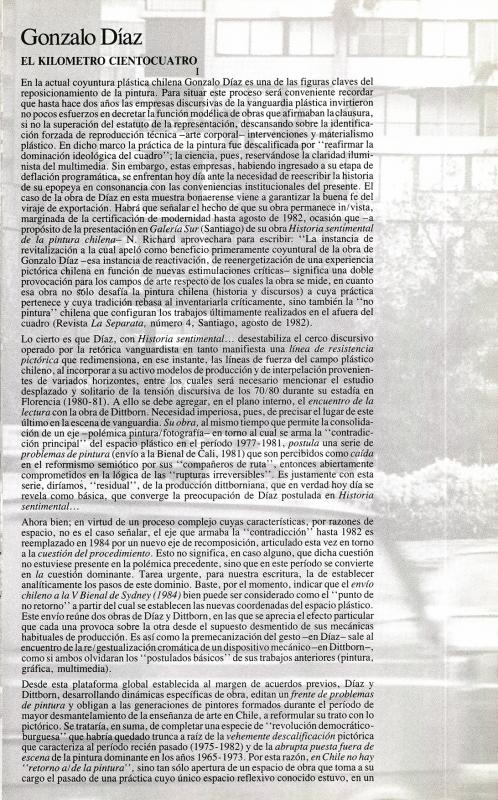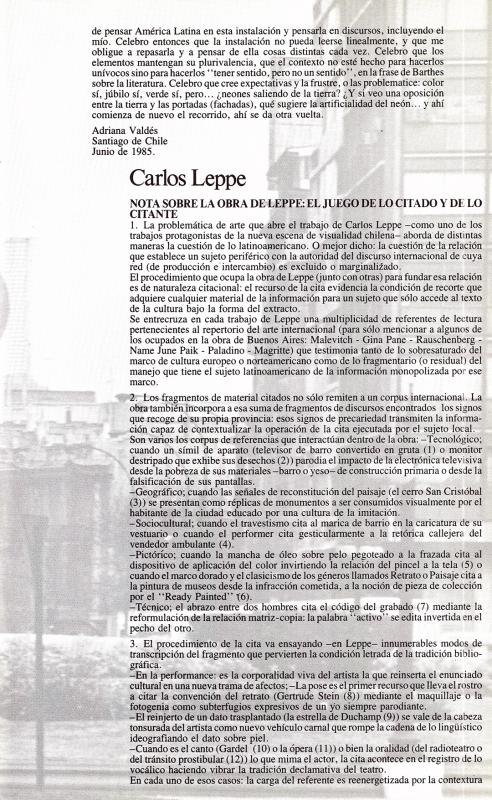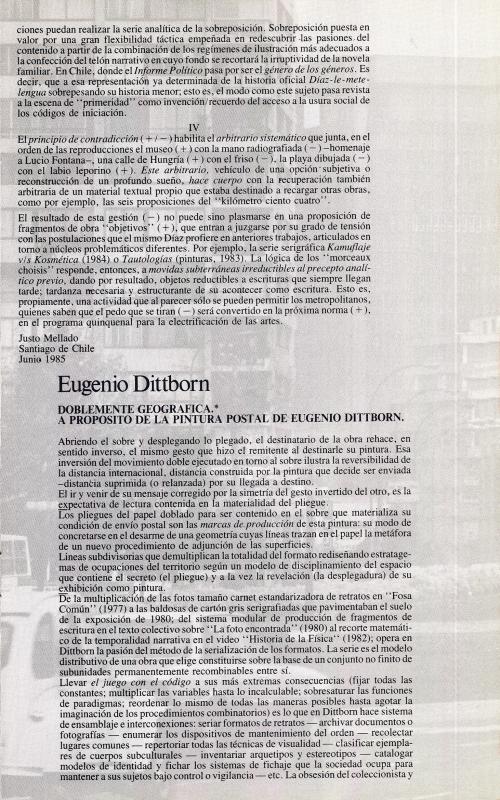The exhibition Cuatro artistas chilenos en el CAYC de Buenos Aires: Díaz, Dittborn, Jaar, Leppe was held at the CAYC (Centro de Arte y Comunicación) in Buenos Aires in 1985. The four participating artists were Gonzalo Díaz (b. 1947), Eugenio Dittborn (b. 1943), Alfredo Jaar (b. 1956), and Carlos Leppe (b. 1952). The exhibition was co-curated by the theorist and cultural critic Nelly Richard (b. 1948) and Jorge Glusberg (1932–2012), the founder and director of the CAYC.
Richard, Adriana Valdés (b. 1943), and Justo Pastor Mellado (b. 1949) contributed articles to the catalogue. Rather than reviewing the pieces presented at the exhibition, the catalogue texts focused on their production. [See the other catalogue texts in the ICAA Digital Archive: "Gonzalo Díaz: El Kilómetro cientocuatro" (doc. no. 734722) by Justo Pastor Mellado; see also "Carlos Leppe: Nota sobre la obra de Leppe" (doc. no. 734807) and "Eugenio Dittborn: Doblemente geográfico. A propósito de la pintura postal" (doc. no. 734740), both by Nelly Richard].
In Chile during the 1970s and 1980s, artists and theorists worked together in an unprecedented way, creating written critical works that paralleled the art scene of the period. Jaar and Valdés are still collaborating to this day, despite the fact that he has lived in New York since the early 1980s. His Estudios sobre la felicidad (1979–81)—which included texts by Valdés—was one of the most important works created in Chile at the time. It consisted of installations and events staged in public spaces and used video and photography to produce both art and documentation. The question that prompted the exploration of all those supports—¿Es usted feliz? (Are You Happy?)—was addressed to the depressed Chilean people living under the repressive conditions of the military dictatorship (1973–90).
Valdés’s interpretation of the works that Jaar produced in the late 1970s and early 1980s—focused mainly on the open nature of the installations that depended on viewer participation—is buttressed in the text that appears in the catalogue produced by the CAYC in Buenos Aires. Visitors are encouraged to participate by getting involved in the installation’s process and the use of everyday elements.
The installation was created expressly for the CAYC and titled O Adeus (The Goodbye). It was inspired by the death of Tancredo Neves, who was elected president of Brazil at the end of a decades-long dictatorship (1964–85), but died of medical complications before he could take office. It was also a salute to the democratic presidency of Raúl Alfonsín after three decades of authoritarian military rule in Argentina. The installation presented reproductions of front-page announcements of two historic events—the death of Neves and the inauguration of Alfonsín—with neon lights illuminating the reports about Alfonsín. It was a tribute to Brazil and Argentina and their sociopolitical circumstances at the time. It was reinstalled in 2020 at La exposición olvidada y una lectura a Cuatro artistas chilenos. CAYC Chile/Argentina, the exhibition curated by the art historians Mariana Marchesi (b. 1972) and Sebastián Vidal (b. 1978) at the Museo Nacional de Bellas Artes in Santiago.



